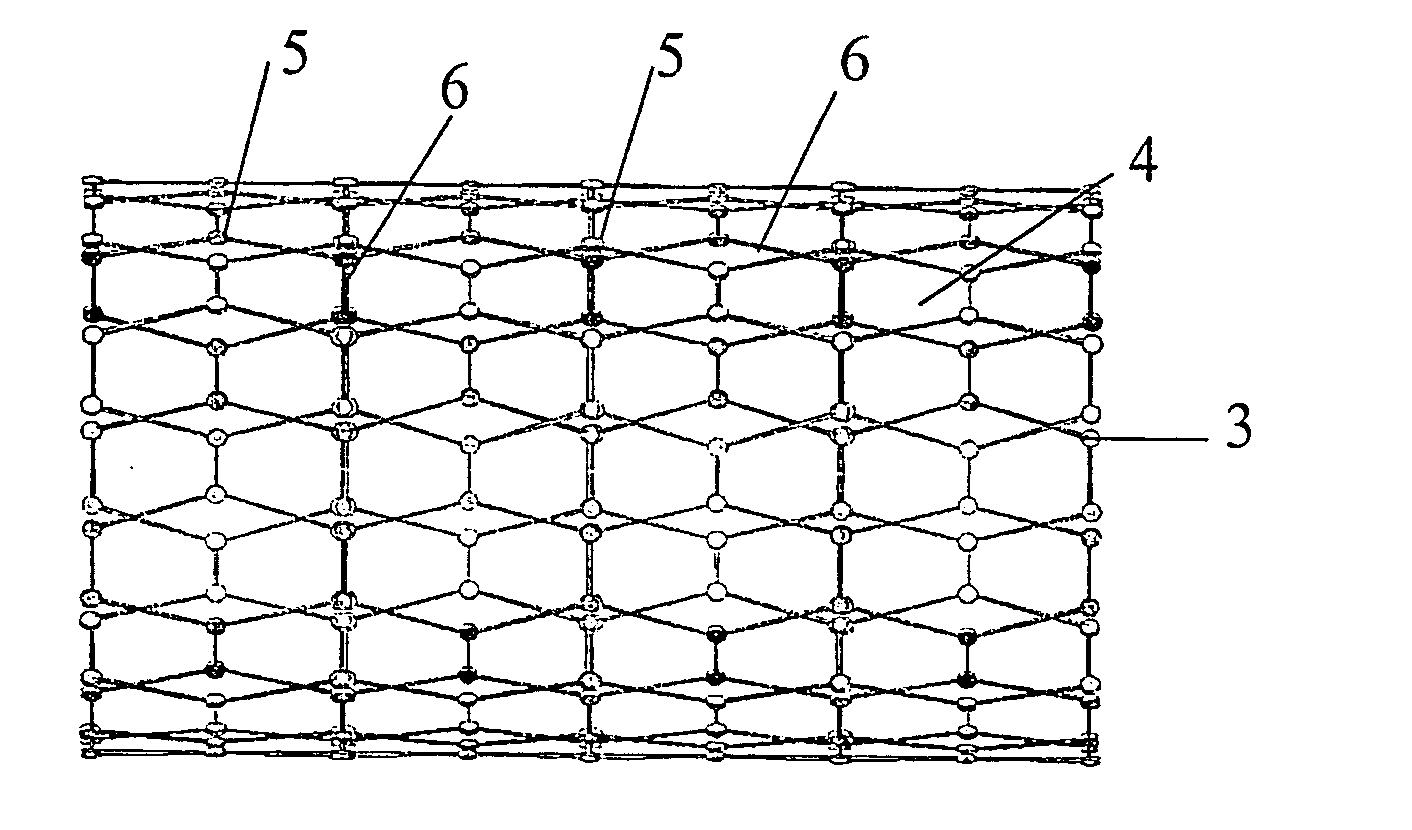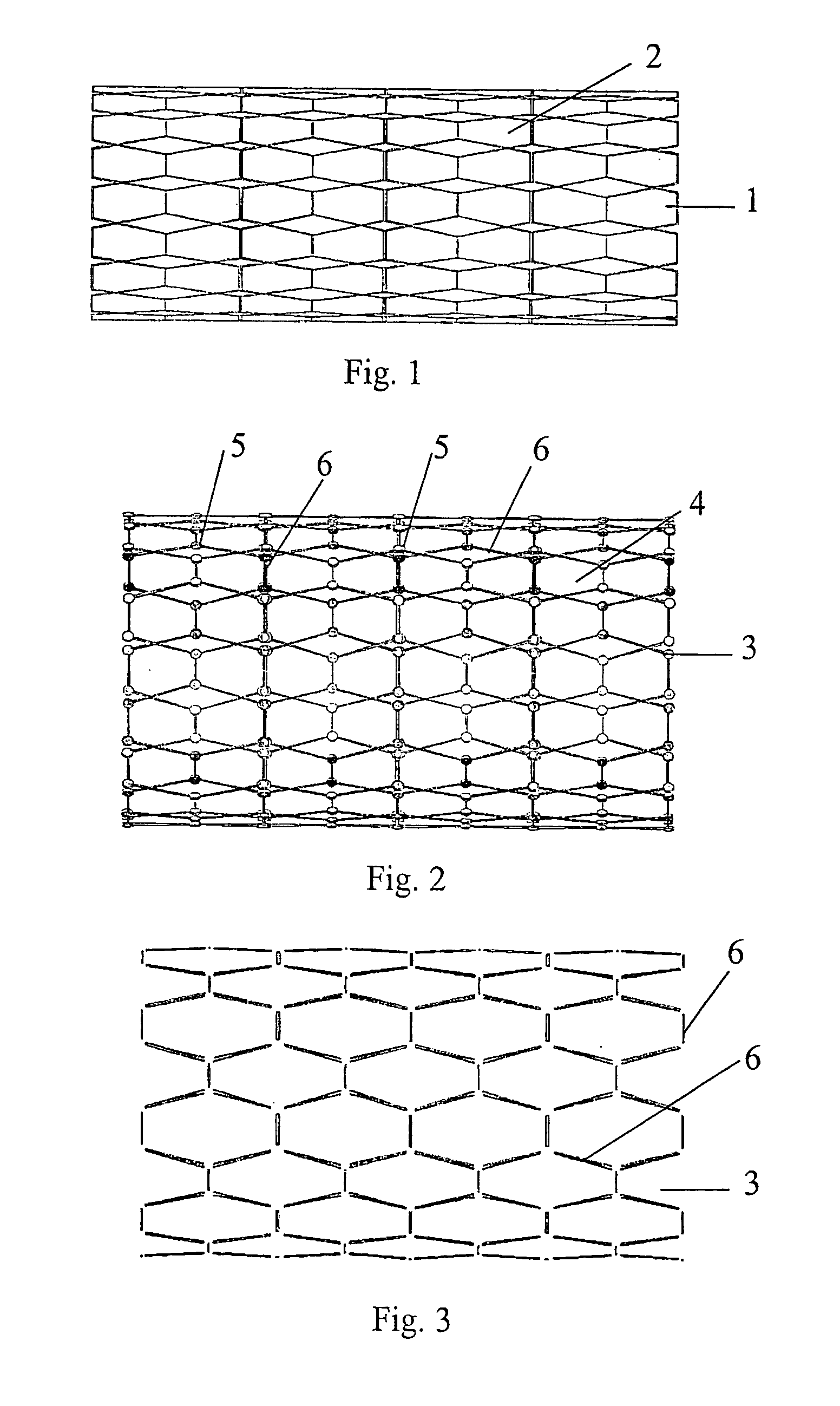Stent
a stent and expandable technology, applied in the field of expandable stents, can solve the problems of difficult removal of metal mesh stents, risk of restenosis, and still a substantial risk of having a restenosis
- Summary
- Abstract
- Description
- Claims
- Application Information
AI Technical Summary
Benefits of technology
Problems solved by technology
Method used
Image
Examples
first embodiment
[0028]FIG. 1 illustrates an inventive stent. In FIG. 1, a stent 1 comprises a mesh 2 made of metal that corrodes in the environment prevailing inside a vessel. By choosing a suitable metal, it is possible to control the time elapsed until the stent is dissolved by corrosion inside the vessel. Obviously, this time depends on the physiological and chemical characteristics of both the vessel itself and the fluid flowing inside the vessel as well as for how long time it is necessary to support the stented vessel. A perhaps natural choice of metal would in this case be iron, or possibly an alloy of iron and a small amount of chromium or nickel in order to make the stent more resistant to corrosion, i.e. prolong the time before the stent is dissolved inside the vessel. In practise, the choice of metal or alloy may be tailored to the actual application.
second embodiment
[0029] an inventive stent is illustrated in FIG. 2. Here, a stent 3 comprises a metal mesh 4, which comprises two component parts, joining 5 and interconnecting portions 6. If the joints 5 are made of metal having a lower electrochemical potential than the metal of the interconnecting portions 6, an active galvanic element is created, with the fluid inside the vessel acting as an electrolyte. This galvanic element drives an electrochemical process, in which the metal having the lower electrochemical potential is consumed, which, in this case, means that the joining portions 5 of the mesh 4 are dissolved, thereby leaving the mesh 4 in a disintegrated configuration. This disintegrated configuration is shown in FIG. 3. As is well known, the kinetics of corrosion reactions may in actual practise differ from that predicted by electrochemical potentials in standard electrochemical series. When deciding metal combinations, one must therefore also take into account the characteristics of th...
third embodiment
[0031] A more general third embodiment of the present invention is illustrated by FIGS. 2 and 3, and by FIGS. 6a-6c and 7a-7c.
[0032] By using the same reference signs, in FIGS. 6a-6c and 7a-7c, as in FIG. 2 the generalised expandable stent 3 comprises a mesh structure 4 of interconnecting portions 6 joined together by joining portions 5.
[0033] According to this third embodiment the joining portions are made from a first material and the interconnecting portions are made from a second material different from said first material, wherein the first material dissolves faster than said second material.
[0034] By using this mesh structure the stent dissolves in such a way that the longitudinal structural integrity initially is decreased and that the longitudinal structural integrity decreases faster than the radial structural integrity decreases. The radial structural integrity is related to the forces exerted by the stent towards the body passage wall. Thereby the flexibility of the st...
PUM
| Property | Measurement | Unit |
|---|---|---|
| Time | aaaaa | aaaaa |
| Thickness | aaaaa | aaaaa |
| Corrosion properties | aaaaa | aaaaa |
Abstract
Description
Claims
Application Information
 Login to View More
Login to View More - R&D
- Intellectual Property
- Life Sciences
- Materials
- Tech Scout
- Unparalleled Data Quality
- Higher Quality Content
- 60% Fewer Hallucinations
Browse by: Latest US Patents, China's latest patents, Technical Efficacy Thesaurus, Application Domain, Technology Topic, Popular Technical Reports.
© 2025 PatSnap. All rights reserved.Legal|Privacy policy|Modern Slavery Act Transparency Statement|Sitemap|About US| Contact US: help@patsnap.com



